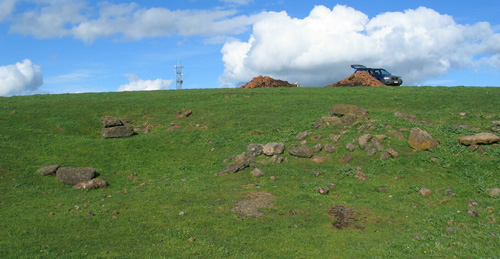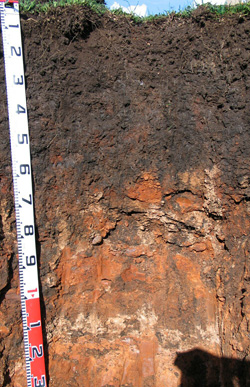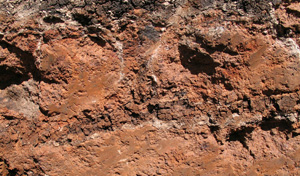SW111
Location: Mt Gellibrand.
Australian Soil Classification: Vertic (& Calcic), Black DERMOSOL (clayey surface).
General Landscape Description: Flat crest of Mt Gellibrand.
Site Description: Grazing paddock.
Geology: Late Quaternary basaltic scoria.
Soil Type: “Mountain Soil” Leeper et al. (1936)
 SW111 Landscape |
Soil Profile Morphology:
Surface Soil
| A1 | 0-15 cm | Very dark grey (10YR3/1); medium clay; strong medium to fine polyhedral structure; strong consistence dry; abundant roots; pH 6.4; clear change to: |  SW111 Profile SW111 Profile |
| Subsoil | |||
| B21 | 15-30 cm | Black (10YR2/1); heavy clay; strong medium to fine sub-angular blocky structure; strong consistence dry; pH 6.7; clear change to: | |
| B22 | 30-55 cm | Black (10YR2/1) with few dusky red (2.5YR3/4) and reddish brown (5YR4/3) mottles; heavy clay; strong coarse to medium sub-angular blocky structure; strong consistence dry; slickensides present; shiny faced peds; pH 7.5; clear change to: | |
| B23 | 55-70/80 cm | Black (10YR2/1) with few brown (7.5YR5/4 and 4/4) mottles; heavy clay; strong coarse to medium sub-angular blocky structure; strong consistence dry; slickensides present; shiny faced peds; includes some weathered scoria; pH 8.8; clear change to: | |
| B24k | 70/80-85 cm | Very dark grey (10YR3/1) with brown (7.5YR4/4) mottles; medium clay; many (20%) semi-hard calcareous nodules; abrupt and wavy change to; pH 9: | |
| C1 | 85-100/105 cm | Mainly (>90%) weathered scoria with narrow bands of structured clay: | |
| 2B1 | 100/105-110 cm | Strong brown (7.5YR5/6); strong medium sub-angular blocky structure; clay; dark stains along ped faces: | |
| 2B2k | 110-115 cm | Many fine-earth carbonates and structured clay material: | |
| 2BC2 | 115+ cm | Successive layers of scoria with sometimes interceding layers of structured clay material. | |
 | Scoria - Vesicular glassy fragments of basaltic composition, partly cemented, generally permeable and readily weathered can be seen exposed in a small excavation west of soil pit. |
Key Profile Features:
|
Soil Profile Characteristics:
pH | Salinity Rating | |||
Surface (A1 horizon) | Slightly Acid | Low | Non-Sodic | None1 |
Subsoil (B21 horizon) | Slightly Acid | Very Low | Non-Sodic | Moderate2 |
Deeper subsoil (at 55-80 cm) | Strongly Alkaline | Low-Medium | Sodic | None3 |

| The surface (A) horizon and upper subsoil are slightly acid. The deeper subsoil is strongly alkaline. | The salinity rating is low in the surface. The subsoil is very low becoming moderate at depth. | The surface and upper subsoil is non sodic. The deeper subsoil at 55-80 cm becomes sodic and strongly sodic at 1 m. |
|
Horizon | Horizon Depth (cm) | pH (water) | pH (CaCl2) | EC dS/m | NaCl % | Total Nitrogen % | Organic Carbon % | Exchangeable Cations | |||
Ca | Mg | K | Na | ||||||||
meq/100g | |||||||||||
A1 | 0-15 | 6.4 | 5.7 | 0.16 | 0.45 | 5.5 | 18 | 14 | 3 | 1.4 | |
B21 | 15-30 | 6.7 | 5.8 | 0.15 | 0.25 | 3.1 | 19 | 17 | 2.8 | 1.9 | |
B22 | 30-55 | 7.5 | 6.6 | 0.17 | 0.20 | 2.5 | 21 | 21 | 2.2 | 3 | |
B23 | 55-80 | 8.8 | 8.2 | 0.55 | 0.04 | 21 | 28 | 1.6 | 6.1 | ||
B24k | 100-105 | 9 | 8.9 | 0.86 | 0.07 | 18 | 41 | 1.4 | 12 | ||
Horizon | Horizon Depth (cm) | Extractable Iron % | Extractable Aluminium % | Exchangeable Aluminium mg/kg | Exchangeable Acidity meq/100g | Field Capacity pF2.5 | Wilting Point pF4.2 | Coarse Sand (0.2-2.0 mm) | Fine Sand (0.02-0.2 mm) | Silt (0.002-0.02 mm) | Clay (<0.002 mm) |
A1 | 0-15 | 2.2 | 0.23 | 15 | 16 | 44.9 | 33.5 | 11 | 11 | 14 | 54 |
B21 | 15-30 | 2.3 | 0.26 | 15 | 48.4 | 35.8 | 7 | 10 | 10 | 66 | |
B22 | 30-55 | 2.3 | 0.25 | 11 | 57.9 | 37.9 | 6 | 10 | 10 | 69 | |
B23 | 55-80 | 57.9 | 41.2 | 4 | 9 | 11 | 63 | ||||
B24k | 100-105 | 4 | 12 | 31 | 44 |
Notes: Geology and landform described by Bernie Joyce.
Profile Described By: Mark Imhof, John Martin, Jack Holland and Bernie Joyce (October 2004).
Reference:
Leeper GW, Nicholls A and Wadham SM (1936). Soil and Pasture Studies in the Mount Gellibrand area, Western District of Victoria. Proceedings Royal Society Victoria, 49.


